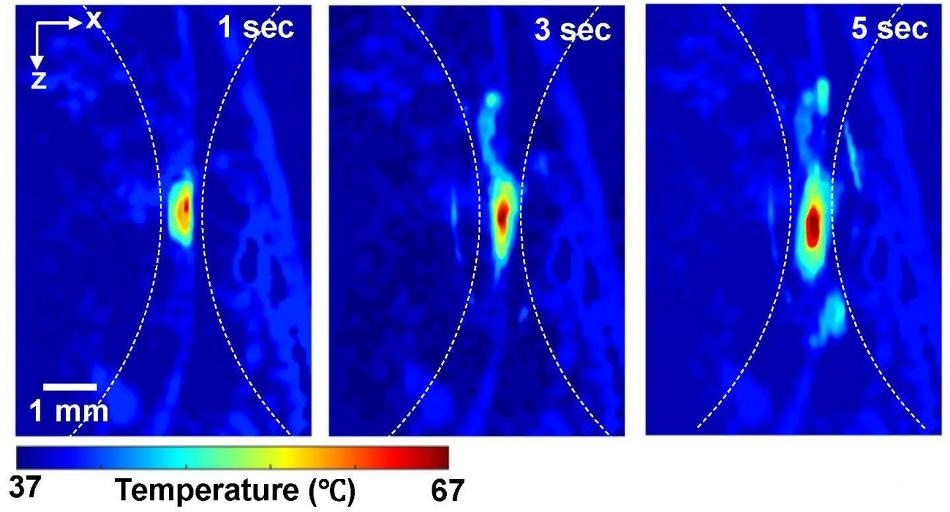Feb 14 2019
Usually, it is quite simple to measure a fever: simple place a thermometer under the tongue of a patient and obtain a precise temperature reading within a period of 30 seconds.
 Photoacoustic imaging shows the absolute temperatures elevated by high-intensity focused ultrasound in small animal models at one, three and five seconds. (Image credit: Junjie Yao, Duke University)
Photoacoustic imaging shows the absolute temperatures elevated by high-intensity focused ultrasound in small animal models at one, three and five seconds. (Image credit: Junjie Yao, Duke University)
However, when it comes to determining the temperatures of particular tissues deep within the body, that simplicity does not work.
At Duke University, biomedical engineers have shown how photoacoustic imaging has the ability to take the temperature of tissues deep inside the body in a relatively fast and accurate way when compared to present methods. This latest breakthrough is anticipated to play an integral role in developing thermal-based therapies for treating cancer. The results of the study have been reported in the journal Optica on February 12th, 2019.
It is important to monitor the temperature of internal tissues for thermal therapies of cancers and for many biomedical studies, usually influencing the efficiency or side effects of the treatment.
If we use MRI or ultrasound, we’re looking at relative temperature and operating under the assumption that the patient has a baseline temperature of 98 degrees Fahrenheit, which isn’t always the case. We found a way to measure absolute temperature by using photoacoustic imaging to probe the thermal memory of the tissue.
Junjie Yao, Assistant Professor, Biomedical Engineering, Duke University
As the name suggests, photoacoustic imaging enables scientists to integrate the properties of both sound and light. Through this method, researchers can change the light shined through the tissue into ultrasound waves that can be subsequently examined to produce high-resolution images.
“It’s basically compressing one second’s worth of summer-noon sunlight over a fingernail area in a single nanosecond,” stated Yao, who has been studying the technology for almost 10 years. “When the laser hits a cell, the energy causes it to heat up a tiny bit and expand instantaneously, creating an ultrasonic wave. It’s analogous to striking a bell to cause it to ring.”
For a long time, scientists have wanted to apply photoacoustic imaging to determine temperature but they have always encountered technical barriers, informed Yao.
The conversion efficiency between light and sound is temperature-dependent, so we know it's possible to measure temperature by listening to soundwaves generated by light. However, we haven’t previously been able to measure absolute temperature because the process itself needs to know how many photons are reaching the tissue, which is technically challenging.
Junjie Yao, Assistant Professor, Biomedical Engineering, Duke University
To solve this missing data, Yao has partnered with Pei Zhong, a professor in the department of mechanical engineering and materials science, who used high intensity focused ultrasound (HIFU) to produce deep tissue heating. The duo’s team developed a novel technique called thermal-energy-memory-based photoacoustic thermometry, or TEMPT in short, which utilizes photoacoustic imaging to determine the “thermal memory” of the tissue.
Using this TEMPT technique, researchers typically obtain a baseline temperature reading before applying a burst of nanosecond-long laser pulses to bombard the tissue. The pulses momentarily increase the temperature of the tissue, and another photoacoustic pulse is used to subsequently measure this temperature. These measurements were used by the research team and a mathematical model was eventually developed to estimate the absolute temperature without knowing the actual number of photons that were delivered.
The potential to more accurately determine the temperature of tissues deep inside the body holds important implications for using the thermal ablation technique to treat cancer. In thermal ablation, tumor cells are heated up using radio waves or HIFU until they die. Even though thermotherapy is a potential new treatment in the battle of combating cancers, investigators are quite excited related to this therapy because it doesn’t lead to adverse side-effects which are associated with chemotherapy and radiotherapy.
“One of the challenges with thermotherapy is that we need to keep the temperature in the most efficient range,” stated Yao. “If the temperature is too high, we can damage the surrounding tissues, and if it’s too low, we’re not causing enough damage to the tumor. The TEMPT technology could be incorporated into the treatments to hone in on the perfect temperature.”
According to Yao, researchers are looking forward to investigate the most accurate temperature range to efficiently destroy tumor cells. Apart from the therapeutic potential, Yao and his partners are also exploring how their research can be applied to other critical research questions.
We’re already forming new collaborations, both with physicians and engineers, to continue to advance this new technology in the lab and beyond. This is very exciting because it can potentially be translated to clinical impacts and benefit cancer patients.
Junjie Yao, Assistant Professor, Biomedical Engineering, Duke University
The study was supported by the Duke MEDx Basic Science Pilot Grant, Duke Center for Genomic and Computational Biology Faculty Pilot Research Grant, the American Heart Association Collaborative Sciences Award (18CSA34080277); National Key R&D Program of China (2016YFC0102200); National Natural Science Foundation of China (NSFC) (81471665 and 81561168023), and National Institutes of Health (R37-DK052985-21).